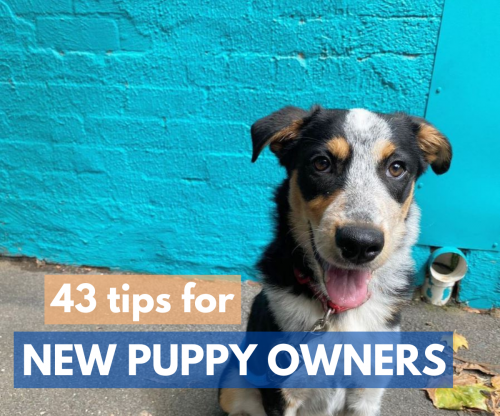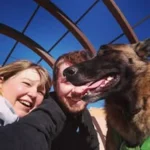Last updated: May 13, 2025
It’s around day three of life with a new puppy that most people start to ask themselves “what the hell have I gotten myself into?”
Between managing the puppy’s destructive tendencies, worrying about stuff like socialization, and being bombarded with well-intentioned but questionable advice from friends, family, and TV shows, a puppy parent can get a liiiiittle overwhelmed.
So here are some bite-sized puppy tips to get you through the next few months.
1. Don’t compare your training progress to the InstaTubeTok trainers whose puppies learn like 50 tricks and can do their own laundry by the time they’re ten weeks old. The truth is that there are no commands your puppy has to learn immediately. It’s okay to go slow.
2. Remember that your puppy is a baby – try not to ask too much of her. Don’t worry about whether she’ll perform a perfect sit/stay or heel. There will be plenty of time for that when she’s older. Focus on socialization, building a relationship, and having fun.
3. There will probably be moments when you regret getting this puppy. This is normal. Do not panic. It’s called the “WTF Was I Thinking?!” phase. Watch me explain in this video:
4. Take time for yourself. #selfcare Puppies are exhausting. It’s easy to get burned out, especially if you can’t get any breaks. Trade puppy care shifts with your family members. Or see if a friend would be willing to puppysit for an afternoon. If nothing else, it’s okay to put the puppy in their crate with a peanut butter-filled puzzle toy so you can get out of the house for a little while.
5. Most puppies have a low tolerance for frustration. If Sparky wants something but he’s held back from getting it or doesn’t understand how to get it, a bitey tantrum may ensue. They need to be taught calm ways to ask for what they want. In our Puppy Survival School program, we teach our puppies how to “say please.”
6. Focus on what you want your puppy to do, not what you don’t want. You can yell at Sparky not to jump on Grandma all you want, while Sparky just says “but how ELSE am I supposed to say hello to her?!”
7. Just like human toddlers, puppies can be obnoxious when due for a nap. They need many naps per day. Sleep quality is key: in a quiet area where they feel secure. I know sleeping puppies are irresistible, but don’t let anyone bother Sparky when she’s napping.
8. Play some puppy training games.
9. “Hyper Attack Mode” is when puppies get extra bitey. It’s usually a sign that one of their needs aren’t being met. Like the need for sleep (see above), play, exercise, LESS exercise, etc. When Sparky gets crazy, ask yourself what he might be asking for. (We have a whole course on biting in Puppy Survival School to help you take the guesswork out of this process)
10. When you get frustrated, remember that the puppy is probably just as frustrated as you are. He isn’t trying to piss you off or dominate you. He’s a lil’ baby who’s been taken away from his mom, and thrown into a strange new place where he doesn’t speak the language. He’s doing his best. On that note:
11. Think cooperation, not confrontation. Stand in solidarity with your pup. “I know this is hard, but we’re gonna figure it out together!”
12. When Sparky does something you like, reward her. Any behavior that gets rewarded is likely to be repeated.
13. The way to a dog’s (and tbh, a human’s) heart is truly through their stomach. So don’t be afraid to use food in training. Food-based training can jump-start your bond by teaching your dog that you are fun, trustworthy, and the Provider of Good Things.
14. Provide lots of toys. Get a variety to see what kind your puppy likes best.
15. Provide lots of delicious chews. Things like bully sticks and pig ears. These will satisfy your pup’s need to chew, and make her less likely to chew on your valuables.
16. Rotate through the dog toys. Let your puppy have three or four toys at a time. Changing up the toy selection will keep Sparky interested.
17. Got an older dog or cat? Give them a puppy-free place to themselves. Life with a new pup can be overwhelming for everyone, including your other pets. Make sure they have the ability to escape the madness if they need to.
18. If you think your puppy needs to pee at all, don’t hesitate to take him outside. You might be surprised how often puppies need to go.
19. Make sure everyone is on the same page. Discuss the puppy rules with your whole family. Figure out who will do what, and when. Pick one set of training cues and stick with them.
20. Set realistic expectations for how long house training will take. House training is all about forming habits, and it takes a while for habits to become strong. So even if your puppy has a few days of no accidents, don’t slack off!
21. Introduce your pup to all kinds of novel things. People in funny hats. Remote control cars. Kids playing. Agility equipment. Balloons. Cats. Car rides. But remember:
22. Socialize, don’t traumatize. Introduce new experiences slowly and never let your puppy get overwhelmed. Click here to read our beginner’s guide to puppy socialization.
23. Invite friends and family over to meet the puppy. Good for socialization. (If your pup is shy, invite people over one at a time)
24. Set a daily routine. House training proceeds more smoothly if your puppy knows what to expect from her day.
25. Relationships take time to build. You wouldn’t meet a new human and expect to be BFFs on day one – getting to know, love, and trust someone takes time. So don’t be discouraged if it takes your puppy a while to warm up to you.
26. Visit the vet. Take your pup for a visit when she doesn’t have an appointment. Bring some treats and ask the office staff to give her some. Make the vet’s office a fun place! (call ahead first to make sure this is okay)
27. Don’t worry too much when your puppy chews on you. Puppies bite. Sometimes painfully! But it’s not aggression, and this phase doesn’t last forever.
28. When it comes to exercise, think Goldilocks: not too much, not too little. Too much exercise can actually make puppies MORE hyper. Kind of like a kid who only gets more jazzed up after an hour running around Disneyland. One of the first things we do with our virtual coaching clients is help them figure out the right blend of exercise, calmer interactive activities (like training), and calm solo activities (like chewing a bone) that will wear their puppy out effectively.
29. Leave the TV or radio on when you leave your puppy home alone. Some puppies seem to find the background noise comforting.
30. Pick up anything you don’t want destroyed. If it’s on the floor, it WILL be chewed.
31. Supervise interactions between all your babies (human and canine) closely. Little kids can quickly get overwhelmed by puppy biting. Puppies can quickly get overwhelmed by enthusiastic children.
32. Get a few Kong-type toys, fill them with smearable food like canned dog food, cottage cheese, or peanut butter. Stick them in the freezer. When you need to keep the puppy entertained but you don’t have time, give them one of their frozen “Kong pops.”
33. Get your puppy microchipped. It’s your best chance at being reunited with your dog if he ever gets lost. You can get this done for around $25 at your vet or local shelter.
34. Don’t worry, you don’t have to be the pack leader. That’s a fossilized dinosaur of a myth. Successful puppy-raising is more like being a parent than being a tough “alpha.”
35. Go with the flow. A lot of the joy of raising a puppy comes from discovering who they are, not in molding them into the perfect dog. You might want your dog to like activity A, but if it turns out they prefer activity B? That’s okay!
36. For bedding, use old towels or blankets that you don’t mind getting destroyed. Puppy bedding will probably get chewed on or peed on at some point, so save the cute, expensive dog beds for when they’re a bit older.
37. Ditch the food bowl. Feeding your puppy out of food-dispensing puzzle toys will keep her busy (and out of trouble) longer, and provide much-needed enrichment.
38. If your puppy chews on their leash, it’s probably because they’re frustrated. A leash is a strange new sensation! Taking time to patiently teach them how to walk with a leash will help.
We have four leash training exercises in Puppy Survival School, but here’s a good place to start: In your living room, clip the leash to Sparky’s collar. Grab leash, take a few steps backwards, happily call him, and give him a treat when he gets to you. Repeat.
39. Let your puppy sleep in your bedroom, at least for the first few nights. This whole experience is pretty scary for a pup, so it’s best not to make him sleep in the laundry room just yet. Put the crate next to your bed so you can reassure him.
40. Baby gates are your friend. Use them to keep the puppy out of places you don’t want her to destroy.
41. Avoid the dog park. In addition to putting your under-vaccinated puppy at risk for disease, many dogs at the dog park are quite rude by canine standards. A couple bad experiences could ruin your puppy’s opinion of her own species. Save that for when she’s older and has had lots of good socialization experiences.
42. Don’t believe everything you read on the internet. Take everyone’s advice with a grain of salt. Even our advice.
43. Take lots of pictures. Despite the fact that it seems to last forever when you’re in the middle of the sleep deprivation and potty training stage, puppyhood goes by fast. And we always miss it when it’s over. (And tag us in your puppy pics @threelostdogs on Instagram!)





